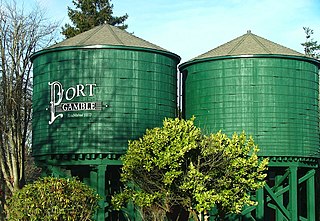
Port Gamble is an unincorporated community on the northwestern shore of the Kitsap Peninsula in Kitsap County, Washington, United States. It is also a small, eponymous bay, along which the community lies, near the entrance to Hood Canal. The unincorporated communities of Port Gamble and Little Boston, part of Kitsap County, lie on the west and the east side, respectively, of the mouth of this bay. The Port Gamble Historic District, a U.S. National Historic Landmark, covers one of the nation's best-preserved western lumber towns.

The steamship Virginia V is one of two last operational examples of Puget Sound Mosquito Fleet steamers. She was once part of a large fleet of small passenger and freight carrying ships that linked the islands and ports of Puget Sound in Washington state in the late 19th and early 20th centuries. She is a Seattle landmark and a National Historic Landmark.
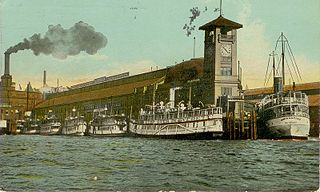
The Puget Sound mosquito fleet was a multitude of private transportation companies running smaller passenger and freight boats on Puget Sound and nearby waterways and rivers. This large group of steamers and sternwheelers plied the waters of Puget Sound, stopping at every waterfront dock. The historical period defining the beginning and end of the mosquito fleet is ambiguous, but the peak of activity occurred between the First and Second World Wars.
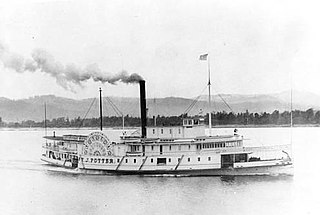
The T.J. Potter was a paddle steamer that operated in the Northwestern United States. The boat was launched in 1888. Her upper cabins came from the steamboat Wide West. This required some modification, because the T.J. Potter was a side-wheeler, whereas the Wide West had been a stern-wheeler. The boat's first owner was the Oregon Railway and Navigation Company. The T. J. Potter was one of the few side-wheeler boats that operated on the Columbia River.

Lake Washington steamboats and ferries operated from about 1875 to 1951, transporting passengers, vehicles and freight across Lake Washington, a large lake to the east of Seattle, Washington. Before modern highways and bridges were built, the only means of crossing the lake, other than the traditional canoe or rowboat, was by steamboat, and, later, by ferry. While there was no easily navigable connection to Puget Sound, the Lake Washington Ship Canal now connects Lake Washington to Lake Union, and from there Puget Sound is reached by way of the Hiram M. Chittenden Locks.
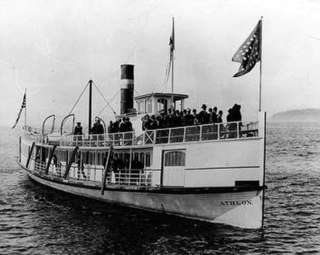
Athlon was a typical passenger steamboat of the Puget Sound Mosquito Fleet.

The steamboat Aquilo operated on Lake Washington and Puget Sound in the first part of the 20th century.

The steamboat Daily operated in the early 1900s as part of the Puget Sound Mosquito Fleet. In later years, Daily was renamed Island Princess and later Cy Peck.

The steamboat George E. Starr operated in late 19th century as part of the Puget Sound Mosquito Fleet and also operated out of Victoria, B.C. Geo. E. Starr also served for a time in California and on the Columbia River.

For the passenger steamer that sank in 1901, see SS Islander

The steamboat Rosalie operated from 1893 to 1918 as part of the Puget Sound Mosquito Fleet, also operating out of Victoria, B.C. In 1898, Rosalie went north with many other Puget Sound steamboats to join the Klondike Gold Rush.

The Greyhound was an express passenger steamer that operated from the 1890s to about 1915 on Puget Sound in Washington, United States. This vessel, commonly known as the Hound, the Pup, or the Dog, was of unusual design, having small upper works, but an enormous sternwheel. Unlike many sternwheelers, she was not intended for a dual role as passenger and freighter, but was purpose-built to carry mostly passengers on express runs.

Wilson G. Hunt was a steamboat that ran in the early days of steam navigation on Puget Sound and Sacramento, Fraser, and Columbia Rivers. She was generally known as the Hunt during her years of operation. She had a long career on the west coast of the United States and Canada, and played an important transportation role in the California Gold Rush; it also transported the Governor and the state legislature as the state capital of California moved from Benicia to Sacramento in 1854.

The sidewheeler Idaho was a steamboat that ran on the Columbia River and Puget Sound from 1860 to 1898. There is some confusion as to the origins of the name; many historians have proposed it is the inspiration for the name of the State of Idaho. Considerable doubt has been cast on this due to the fact that it is unclear if the boat was named before or after the idea of 'Idaho' as a territory name was proposed. John Ruckel also allegedly stated he had named the boat after a Native American term meaning 'Gem of the Mountains' he got from a mining friend from what is now Colorado territory. This steamer should not be confused with the many other vessels of the same name, including the sternwheeler Idaho built in 1903 for service on Lake Coeur d'Alene and the steamship Idaho of the Pacific Coast Steamship Line which sank near Port Townsend, Washington.

North Pacific was an early steamboat operating in Puget Sound, on the Columbia River, and in British Columbia and Alaska. The vessel's nickname was "the White Schooner" which was not based on the vessel's rig, but rather on speed, as "to schoon" in nautical parlance originally meant to go fast.
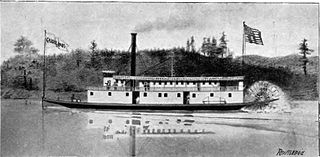
The Carrie Ladd was an important early steamboat on the lower Columbia and lower Willamette rivers. The vessel established the basic design of the Columbia River steamboat, which was later used throughout the Pacific Northwest, British Columbia, Alaska, and the Yukon.
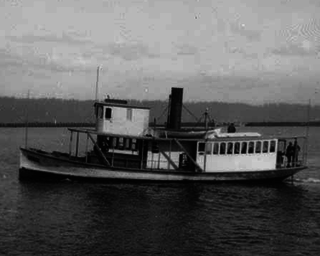
Victor was a steam-powered tugboat built in 1893 in Tacoma, Washington. This vessel should not be confused with the similarly named Victor II, also active in Puget Sound.

The steamer Goliah was the second tug boat ever built in the United States. The long service life of this vessel caused it to become known as the "everlasting" Goliah. This vessel was readily recognizable by its large size and sidewheels. It should not be confused with a number of other vessels named either Goliah or Goliath which were also operating as tugs. This vessel was also sometimes known as the Defender.
Domingo Marcucci Jugo, was a Venezuelan born 49er, shipbuilder and shipowner in San Francisco, California. He owned or captained some of the many steamships, steamboats, ferries, and sailing ships he built at San Francisco and elsewhere on the Pacific coast.
Pope & Talbot, Inc. was a lumber company and shipping company founded by Andrew Jackson Pope and Frederic Talbot in 1849 in San Francisco, California. Pope and Talbot came to California in 1849 from East Machias, Maine. Pope & Talbot lumber company was very successful, with the high demand of the 1849 Gold Rush.


















